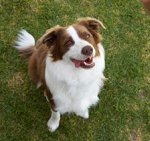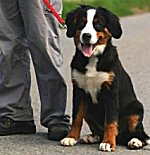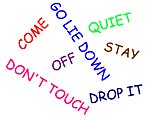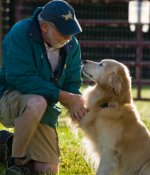Lagotto Romagnolo: What's Good About 'Em, What's Bad About 'Em
Lagotto Romagnolo temperament, personality, training, behavior, pros and cons, advice, and information, by Michele Welton, Dog Trainer, Behavioral Consultant, Author of 15 Dog Books
Jump directly to:
| Temperament | Lively, smart, sensitive, fond of water and mud and digging, loves to run and jump and swim and fetch |
| Pros and Cons | What's good... What's bad... |
| Size | Mid-sized (16-19 inches, 24-35 lbs) |
| Exercise | Moderate to high |
| Training | Easy to moderate |
| With strangers | Varies from friendly to aloof to a bit timid |
| With children | Fine with well-behaved children if raised with children |
| With other pets | Usually good |
| Shedding | Light |
| Grooming | Moderate to significant amount |
| Lifespan | 11-14 years |
| Colors | Brown, orange, white, and combos of those colors |
| Puppies | Moderate availability |
| Rescue dogs | Seldom available |
| Similar breeds | Portuguese Water Dog, Spanish Water Dog, Miniature Poodle |
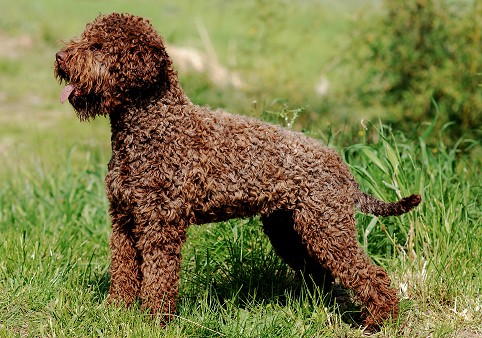
My experience with Lagotto Romagnolo temperament
In a nutshell: lively, athletic, agile, fast, enthusiastic, smart, sensitive, quick learner, fond of water, fond of mud, fond of digging, loves to run and jump and swim and fetch.
Wondering how to pronounce the breed's name? It's Lah-GO-toe Roman-YO-lo. Which refers to the "water dog from the Romanga region of Italy."
The official plural is Lagotti Romagnoli, swapping the final o for an i, which is pronounced like a long e. Like so: Lah-GO-tee Roman-YO-lee.
However, in the US, while some breeders use the Italian plural above, others just say Lagottos.
Temperament and behavior stem from what a breed was designed for
To understand a breed's temperament and behavior, ask, "What was he developed to do?" Whichever traits help him accomplish his intended work have likely been "hard-wired" into his genes – not perfectly, not as reliably as programming a computer, but generally speaking.
The Lagotto Romagnolo is a mid-sized (larger than small, smaller than medium) breed developed in medieval Italy as a water retriever. When the hunter shot down ducks over water, the Lagotto dove in and fetched the downed duck back to the hunter.
So what sort of traits might you need in such a dog? Athleticism... endurance... toughness... willingness to follow directions... water-resistant, tightly-curled wooly coat to protect against the elements...
When the marshlands were converted to farmland, the Lagotto Romagnolo found a new specialty in the Italian countryside: hunting truffles.
Truffles are an edible fungus (similar to a mushroom) with an exquisite taste. Some people are so eager to consume this rare delicacy that they will pay hundreds, even thousands, of dollars for the privilege. There's even a black market industry for truffles. Often called the diamonds of the culinary word, truffles are considered (ounce for ounce) the most expensive food in the world.
Because truffles grow underground and cannot be seen ripening, they are best found by detecting the strong aroma of the mature truffle. This is where the Lagotto comes in, with its great nose and keen work ethic. Growers plant truffle orchards and use their Lagotto to sniff out the first sign of maturing truffles.
What traits might you expect from successful truffle hunters? Boundless energy, a keen desire to search, persistence, determination, and an exquisite sense of smell.
Lagottos have also been trained as Service Dogs able to detect medical conditions such as an imminent seizure or a dangerous blood-sugar drop. In Search & Rescue, Lagottos use their powerful nose to find people trapped under rubble after natural disasters.
So looking at the work a breed was designed for, or is currently being used for, gives us a realistic idea of what that breed is going to be like.
I hope you won't make the mistake of acquiring a Lagotto because you think it's a convenient size for your apartment or because it looks cute and cuddly.
The Lagotto has been bred for working purposes since the 1400s. For centuries, in other words. These dogs have a lot of energy and they need a purpose in their lives.
For example, the Italian Lagotto Club offers truffle-finding (working aptitude) tests throughout Italy. In the US, a variety of stimulating activities can satisfy the Lagotto's craving for something challenging to do.
But don't get the impression that the breed runs wildly around your house all day and needs to be doing something every single hour.
No. But you do need to commit to vigorous exercise and mental stimulation several times a day, even for just 30 minutes at a time. Then the Lagotto will be happy to chill with you in front of the TV the rest of the time. This affectionate dog craves ongoing companionship with his family.
Pros and cons of the Lagotto Romagnolo
The Good
- Convenient size (larger than small, smaller than medium)
- Natural, rustic appearance
- Doesn't shed much
- Athletic, fast, and agile
- Lively, loves to run and jump and swim and fetch
- Good with other animals
- Bright, learns quickly
- Loyal to their own family
The Bad
- Needs a decent-sized fenced yard and frequent sessions of vigorous physical activity (not just walks on a leash) plus challenging mental stimulation
- Needs moderate to significant grooming, including trimming/clipping every couple of months
- Not the best breed for fastidious housekeepers, as the Lagotto likes to splash in water and mud, making a mess and tracking it through the house
- Also the curly, wooly coat attracts dirt, leaves, pollen, and other debris, which can end up on your floor and furniture
- Not the best breed for gardeners, as the Lagotto loves to dig, especially in damp soil
- Susceptible to a number of life-threatening neurological diseases (fortunately most – but not all – of these can be avoided if your pup's parents were simply tested for those diseases before being bred)
- Some individuals are hyper-sensitive (even fearful) of strangers or unfamiliar sights, sounds, or situations
- Not a mindless yapper, but does like to vocalize
 |
Dog Breed Traits – Which Traits Are Right For You? In this brand new series, I'll help you decide which dog breed traits would best suit you and your family, your home and yard, and your lifestyle, so you can choose the best dog breed for your family. |
Keep in mind that the inheritance of temperament is less predictable than the inheritance of physical traits such as size or shedding. Temperament and behavior are also shaped by raising and training.
FREE eBooks by Michele Welton
![]() "Respect Training for Puppies" and "Teach Your Dog 100 English Words" are free step by step guides to teaching your pup to be calm and well-behaved.
"Respect Training for Puppies" and "Teach Your Dog 100 English Words" are free step by step guides to teaching your pup to be calm and well-behaved.
![]() "11 Things You Must Do Right To Keep Your Dog Healthy and Happy" is a free guide to keeping your dog mentally, physically, and emotionally happy and healthy so you can enjoy a longer lifetime of companionship.
"11 Things You Must Do Right To Keep Your Dog Healthy and Happy" is a free guide to keeping your dog mentally, physically, and emotionally happy and healthy so you can enjoy a longer lifetime of companionship.

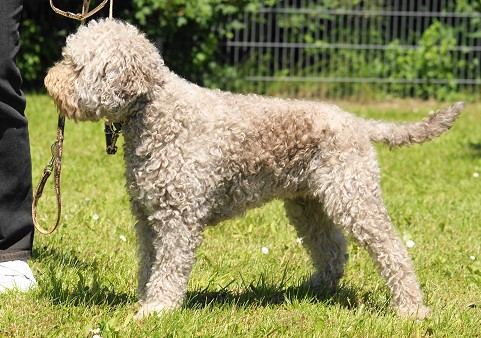
How big is the Lagotto Romagnolo?
Prospective owners who have never seen a Lagotto up-close often think the breed is smaller than it actually is.
This is probably because breeders and breed clubs describe it as "small to medium", which makes some people think the breed comes in a variety of sizes from small to medium, so they can get a "small" one if they want.
Reality check... the Lagotto is not a small breed. Nor is it a medium breed, which would be more like a Border Collie or Springer Spaniel.
The Lagotto Romagnolo is a mid-sized breed:
- Males stand 17 to 19 inches and weigh 28-35 lbs.
- Females stand 16 to 18 inches and weigh 24-31 lbs.
So the Lagotto is about the same weight as a Cocker Spaniel... but the Lagotto stands several inches taller. His build should be square and robust. What it shouldn't be is elegant or fragile.
The AKC Standard says, "The dog should give the impression that he has the strength and endurance to work all day in difficult and challenging terrain."
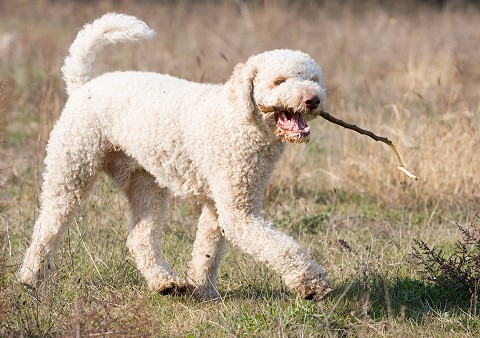
How much exercise does a Lagotto Romagnolo need?
More than you might think!
It's always a concern to me when a casual pet owner gets a breed with a sporting/working ancestry. He often doesn't realize that these breeds require an active lifestyle if you expect their behavior to be calm and content.
In the case of the Lagotto, he doesn't need miles/hours of running exercise. But he definitely wants and needs a decent-sized fenced yard AND frequent sessions of vigorous physical activity (not just walks on a leash) plus challenging mental stimulation. After which a Lagotto will happily snooze in his dog bed.
Mental stimulation means an activity that keeps the dog's intelligent mind occupied – some sort of puzzle to solve. Even owners who diligently provide enough physical exercise often fail to provide the mental aspect.
And what happens if you DON'T provide a sufficiently active lifestyle? Then your Lagotto, with his needs not met, will vent his frustrations via barking, jumping, chewing, and hyperactivity.
What kinds of physical exercise and mental stimulation should you provide a Lagotto?
You probably don't have a lot of truffles in your neck of the woods, but you can substitute some fun nose work activities for your would-be truffle hunter. Nose work means teaching your Lagotto how to alert you when he sniffs out a particular scent. Find more info on these activities on the AKC website.
Another excellent activity for these super-fast athletes is the sport of Agility, an obstacle course for canines. Also Rally obedience, frisbee, flyball, musical freestyle, complex trick routines.... all wonderful activities for a Lagotto.
Finally, with their water dog ancestry, many Lagotti love water, love to retrieve, and love to run and jump. Combine those loves into one activity and you get... dock diving. Check it out! (Or just take your Lagotto swimming.)
If you involve your Lagotto in multiple activities, he can win a Versatility Certificate from the Lagotto Romagnolo Club of America.
Summary: Engage your Lagotto's superb athletic skills and high intelligence with physical and mental activities that channel his natural drive to work.
Are Lagotto Romagnolo easy to train?
In general, a Lagotto whose needs are being met is usually pretty easy to train. Just use a light hand on the leash and establish the right Leader-Follower relationship and the dog will be happy to work with you.
However, some Lagottos are more independent and will use their intelligence to figure out how to do things they want to do. These individuals are too clever/manipulative for a first-time owner.
But most Lagottos learn quickly and respond beautifully to consistent leadership. This is taught in my free online puppy training program, Respect Training For Puppies (30 seconds to a calm, polite, well-behaved puppy).
How sociable is the Lagotto Romagnolo?
Are they friendly with strangers?
Some Lagotti are friendly and outgoing with everyone. But most are a little reserved until they get to know you.
There is shyness/fearfulness in some lines, so if you want an outgoing, confident Lagotto, make sure both of your pup's parents (preferably grandparents, too) are outgoing and confident.
Does the Lagotto make a good watchdog?
Yes! Whether a Lagotto is friendly or reserved toward strangers, he has sharp ears, sharp eyes, and a sharp nose and so makes a reliable alarm dog. Not a guard dog, mind you! Just a dog who sounds the alarm.
In fact, some Lagottos are too enthusiastic about sounding the alarm. They must be taught that a few barks are fine, but then the dog must be quiet and let you take over. This is up to the owner to teach.
Is the Lagotto Romagnolo good with children?
If the dog has a confident temperament and has been raised around children... and if said children are well-behaved, things should go well.
However, some Lagottos are very sensitive and may feel stressed around small children who run, scream, wave their hands around, etc.
Also be aware that young Lagottos can be rowdy. Until you teach them that jumping is not allowed, they could easily cause a young toddler (or an infirm adult) to fall over.
Is the Lagotto Romagnolo good with other pets?
Most Lagotti are fine with other dogs and cats. Unlike most other hunting breeds, most of which have strong instincts to pursue small animals, the Lagotto has been designed to have reduced chasing instincts so the dog wouldn't get distracted by, say, a passing rabbit when on the "hunt" for truffles.
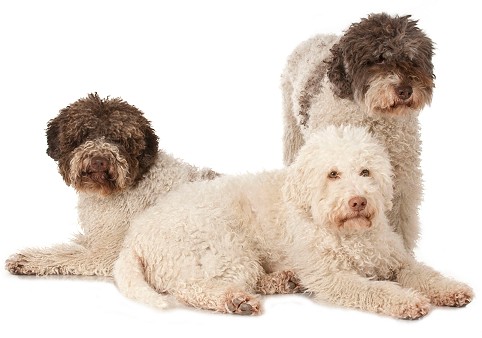
Grooming: does the Lagotto Romagnolo shed a lot? Are they easy to groom?
Technically they don't shed much but that's largely because their shed hairs get caught in the curly coat instead of falling out onto your floor or furniture or clothing. Some people who are allergic to dog hair or dander can live comfortably with a Lagotto. Some people. I really don't recommend this breed if a family member is allergic to dogs.
As far as grooming goes, the time and effort required is moderate to significant. You can see the breed's water dog ancestry in the rustic coat: a thick mass of wooly-textured, tightly-ringed curls atop a dense undercoat. The water-resistant curls feel semi-rough, even harsh to the touch.
A Lagotto puppy's coat does feel soft and is often wavy rather than curly. The correct coarseness and curl will develop over the first 2-3 years.
From a practical perspective, the wooly curls pick up burrs, thorns, leaves, mud.... On an ongoing basis you'll need to remove this debris. You also need to brush the curls as necessary to keep them from fusing together into felted mats, which would otherwise create dark, moist hiding places for parasites, bacteria, and fungi.
The Lagotto's curly hair keeps on growing, so requires regular trimming and clipping. I recommend clipping every 6-8 weeks to keep the curls short, no more than an inch (measured with the coat curled, not brushed out straight). The longer the curls are allowed to grow, the easier it is for them to twist together into a tangled mess.
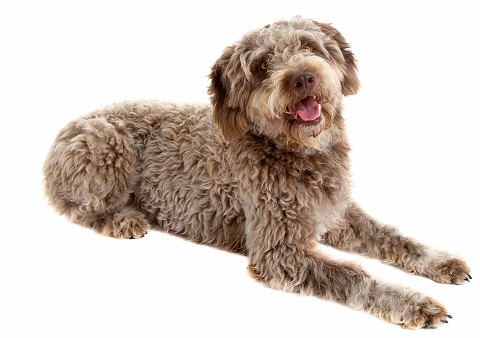
- Keep the beard/whiskers short – when a bearded dog drinks, water soaks up into the hair, then drips all over your house.
- Also keep the hair short around the dog's private parts. Otherwise when he goes to the bathroom, fecal matter will adhere to his bottom and end up transferred to your floor and furnishings.
Very rarely, a Lagotto will be born with a shorthaired coat rather than curly. This is not a health issue, just a trait that breeders and breed clubs don't like. Obviously a shorthaired coat is much easier to maintain, but it does shed more because the shed hairs obviously don't get caught in the curls any more.
Are Lagotto Romagnolo healthy? How long do they live?
The typical lifespan of a Lagotto is 11-14 years.
Overall, their health is good, but they are vulnerable to a few serious health issues.
About 1 of every 4 Lagottos has hip dysplasia, a malformation of the hip joint that causes pain and lameness and leads to chronic arthritis.
The Lagotto can suffer from two different forms of epilepsy. One form appears in young Lagotto Romagnolo puppies and (thankfully) goes away in just a few months... usually, not always. The other form of epilepsy appears in Lagotto adults and requires lifelong medication.
Along with epilepsy, three more neurological diseases (all inherited, all severe) occur in the Lagotto. All of these diseases cause tremors, loss of balance, uncoordinated movements, and tripping/falls.
Here is my complete list of health problems in Lagotto Romagnolo.
See my advice on → keeping your Lagotto healthy
(feeding, vaccinations, neutering, veterinarians, and more).
What colors does the Lagotto Romagnolo come in?
- Various shades of brown (with or without white markings)
- Various shades of "orange" (with or without white markings)
- Off-white (with or without brown or orange patches)
- Brown roan: an even mixture of brown and white hairs that creates a finely speckled pattern
Tan markings are also allowed, but only in the same positions you would see them on a Doberman or Rottweiler: above the eyes, on the cheeks, under the muzzle, on the chest and lower legs, and under the tail.
Fading colors
To avoid disappointment, prospective buyers should understand how colors work on Lagottos – the color usually FADES as the dog matures.
For example, a young puppy might be chocolate brown or golden orange, but as he matures, the rich color fades to a more diluted shade of beige, buff, or cream. (The dog's head, however, often remains a darker shade than the rest of the coat.)
Owners who are unprepared might find themselves unhappy with the diluted color. But you might get lucky.... occasionally a dark brown puppy will maintain his dark shade into adulthood.
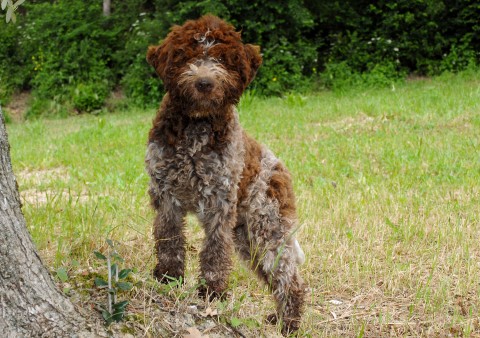
Lagotto Romagnolo Puppies
If you already have a Lagotto Romagnolo puppy....
Congratulations! I'll be happy to show you how to raise and train your new family member.
- Follow my free puppy training book, Respect Training for Puppies: 30 seconds to a calm, polite, well-behaved puppy.
- Also see my advice on Lagotto Romagnolo health care, including feeding and vaccinations
If you don't have a Lagotto Romagnolo puppy, but you want one....
I can help you with that, too.
The best source of a Lagotto puppy is a breeder whose goal is sound structure, temperament, and health (rather than simply winning ribbons in the show ring).
Or you can hop onto Craigslist and buy a Lagotto puppy from someone who "just breeds pets" or "just had one litter." But should you?
Not unless the seller has done the proper health certifications on the puppy's parents. One huge difference between a responsible breeder and an irresponsible "puppy producer" is – health certifications.
BOTH PARENTS of a Lagotto Romagnolo puppy should have:
- a certificate from the Orthopedic Foundation of America (OFA) or PennHip certifying the dog to have normal hips
- a certificate from a board-certified ophthalmologist – dated within the past year – certifying the dog to be free of eye diseases
Also, at least ONE PARENT of a Lagotto Romagnolo puppy should have a DNA test proving they are Normal/Clear of FOUR Lagotto diseases:
- a neurodegenerative disease called LSD (Lagotto Storage Disease).
- a neurodegenerative disease called ND (Neuroaxonal Dystrophy).
- a neurological disease called JE (juvenile epilepsy).
- a urinary disorder called HUU (Hyperuricosuria).
If a seller can't show you those certificates, the puppies are at much higher risk for health problems.
See my advice on → finding a good dog
How do I adopt a Lagotto Romagnolo?
You'll have to get really, really lucky. Lagottos are seldom available from shelters or rescue groups.
Oh, you might see a mid-sized curly-haired dog at a shelter, but it's almost certainly not a Lagotto; the breed just isn't common enough, at least in the United States. Dogs can look like a Lagotto without having any Lagotto Romagnolo genes at all.
So if it's an adult Lagotto you're interested in, your best source is a breeder. They will sometimes offer a retired brood bitch or retired stud dog to a good pet home.
Or one of their own puppies may have been returned to them, now all grown up and needing a new home. However... your question must be: Why was this dog returned? Behavior issues? You need to find out before you unknowingly adopt a problem.
What breeds are similar to a Lagotto Romagnolo?
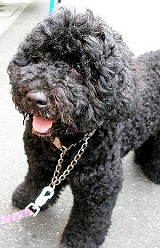
Depending on how he's trimmed, a curly-haired Portuguese Water Dog can look like a Lagotto. Both breeds are athletic nature-lovers who enjoy playing in water and mud. Compared to a Lagotto, the Portuguese Water Dog is larger and stronger-willed.
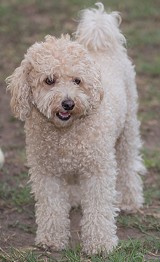
Again depending on trimming style, a Miniature Poodle can resemble a Lagotto. Both breeds are lively, athletic, sensitive, and very bright. Compared to a Lagotto, a Miniature Poodle is a bit smaller, needs less exercise, and is easier to train. If you prefer something a bit larger than a Lagotto, there's an "unofficial" Poodle size called moyen, meaning middle, which is in-between a Miniature Poodle and a Standard Poodle.
My best-selling books – now available FREE on my website
 Respect Training For Puppies: 30 seconds to a calm, polite, well-behaved puppy is for puppies 2 to 18 months old. Your puppy will learn the 21 skills that all family dogs need to know. Click here to read for free.
Respect Training For Puppies: 30 seconds to a calm, polite, well-behaved puppy is for puppies 2 to 18 months old. Your puppy will learn the 21 skills that all family dogs need to know. Click here to read for free. Teach Your Dog 100 English Words is a unique Vocabulary and Respect Training Program that will teach your adult dog to listen to you and do what you say. Click here to read for free.
Teach Your Dog 100 English Words is a unique Vocabulary and Respect Training Program that will teach your adult dog to listen to you and do what you say. Click here to read for free. 11 Things You Must Do Right To Keep Your Dog Healthy and Happy helps your dog live a longer, healthier life. Get my honest advice about all 11 Things before you bring home your new puppy, because some mistakes with early health care cannot be undone. Click here to read for free.
11 Things You Must Do Right To Keep Your Dog Healthy and Happy helps your dog live a longer, healthier life. Get my honest advice about all 11 Things before you bring home your new puppy, because some mistakes with early health care cannot be undone. Click here to read for free.Related posts you might enjoy



